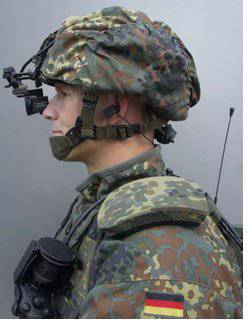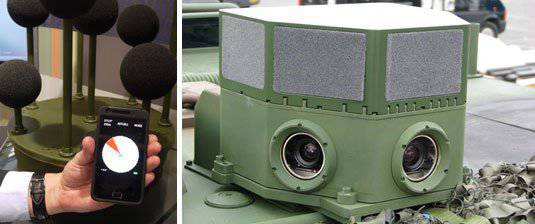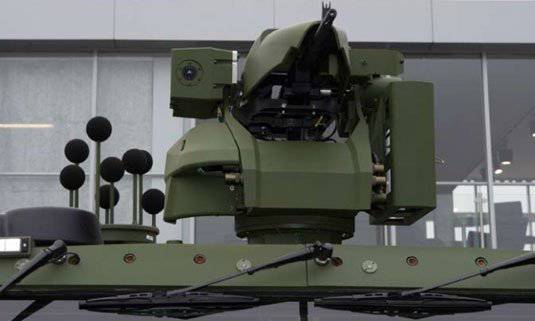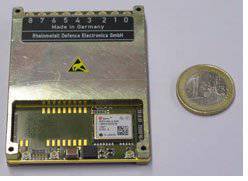Electron ears from Rheinmetall Defense Electronics - ASLS
 Rheinmetall Defense Electronics (Germany) develops advanced acoustic systems for searching and protecting soldiers from artillery and sniper fire.
Rheinmetall Defense Electronics (Germany) develops advanced acoustic systems for searching and protecting soldiers from artillery and sniper fire.Military actions are often associated with noise, and sound pressure from explosions of ammunition sometimes has a traumatic impact.
German engineers wondered: "What could be more natural than using such sounds to find the source of their generation?
Over the past years, RDE specialists from Bremen have gained a lot of experience with acoustic detection, localization and classification of various noise sources on the battlefield, which is relevant from a military point of view.
The last result of such research is the acoustic protection system and localization - ASLS.
ASLS was designed to increase crew protection against gunfire. Practical experience has shown that the vehicle crew often does not suspect that it has been attacked by unfriendly sniper fire. This is due, among other things, to the fact that the personnel are inside the vehicle and are separated from the ambient noise by the vehicle body. Also play a significant role:
noise emitted by the vehicle’s own engine and “parasitic” noises of the battlefield or area of a combat operation.
The research program was sponsored by the German Bundeswehr. The goal of R & D was to implement an automatic system for identification, localization and targeting to the source of a specific noise — the enemy's thunder.

RDE got the opportunity to realize their years of experience with acoustics for reconnaissance purposes:
from the classical localization of detection and tracking of low-flying helicopters, targeting and detection of which is difficult to obtain from radars or other optical-electronic identifiers, up to spatially distributed, network sensors of large acoustic systems for reconnaissance. ASLS is based on highly sensitive microphones that have an “intellectual” function and are capable of selecting and distinguishing noise from a vehicle, shooting, the initial phase of a shot, the explosion of a mine or projectile.
As soon as the projectile leaves the gun, the sound of the shot is identified and localized if the velocity of the projectile (bullet) is subsonic. In this case, the notification of a shot comes before the shot.
If the projectile has a supersonic speed, the system informs the protected object of the type of shot and the coordinates of the attacker immediately after the first shot and makes it possible to react to repetitive ones: hit the target, exit the fire zone, give the CO for impact forces, etc.
Microphones reliably record these sounds and the system as a whole produces selection and localization.

For infantrymen, a special compact ASLS system was developed and tested: localization and protection.
The kit has eight special microphones that are able to withstand a high sound pressure level and have a significant operating time to failure in real conditions. Ordinary microphones may not withstand a sound impact from a bullet.
The mathematically calculated microphone layout, in combination with signal processing software, allows 360 ° to provide coverage and collection of acoustic signals in a relatively simple way. The processing of incoming information signals is carried out in a compact and energy-efficient electronic evaluation unit.
 The power consumption of the unit is less than 1 watts. The dimensions are visible in the photo, very compact.
The power consumption of the unit is less than 1 watts. The dimensions are visible in the photo, very compact.The unit is integrated with a microphone based battery, which has the shape of a cylindrical antenna.
This system - regardless of whether it is located in a vehicle, on an infantryman, or installed remotely, can work for a long time without an external power source.
The signal is processed in the evaluation unit based on the known sonar operation methods and provides the exact location (direction and distance) to the shooter, gun, or triggered ammunition.
The system performance reaches a very low level of response to false alarms even in a “disturbed” environment inside the body of a combat vehicle.
The performance and characteristics of the system far exceed the parameters of human hearing: it can detect frequencies that lie beyond the human hearing, moreover, the system can reliably record very short-term events (lasting a millisecond), or sound vibrations following each other with a very short interval ( which is almost impossible to register with the human ear).
In addition, the ASLS has built-in position (orientation) sensors and a compact GPS sensor.
These sensors take into account and take into account the movement and orientation in space of vehicles or infantry. The position of the attacker is clearly fixed in relation to the protected object.
Events are recorded that are stored locally and can be displayed. Thus, recent events can be analyzed later at any convenient time.
Electronic components and signal processing units have been tested under extreme conditions. Before the shot, the system is in "sleep-stand-by". As soon as the front of the sound wave reaches the microphones, the system is activated, the attack is recorded, the crew is automatically warned by the system of the threat: acoustically and visually.
Results include accurate azimuth, elevation and distance information.
ASLS users are already actively using it when solving everyday tasks.
For users, there are various methods of notification and intuitive control: an independent unit (using the built-in display on the C4I device), or output to a mobile device: a tablet, a smartphone, or displays in other electronic devices.
Thanks to the flexible design, the system can be easily installed on small carriers (UAVs) and non-military objects. The same applies to the adaptation of microphones. Since the electronic evaluation unit and the battery pack are integrated at the base of the cylindrical antenna, additional switching tasks such as connecting to the vehicle's power supply are not needed. However, if there is a need, power from an external source is possible.
ASLS has a high potential for improvement:
[i] - A combination with optoelectronic components such as situational awareness systems (SAS) will be available soon.
- Suppression of the sound level of impact on a person’s ear if the ammunition is about to be broken is also expected in the near future.
Special headphones integrated into the system, having received a signal from the control unit that the sound pressure level was exceeded in milliseconds, protect the infantry’s hearing organs before the body has time to react or get damaged.
-If the MUMT-2 module is available, it is possible to integrate into the overall open architecture system (CAAS) - for example: issuing information and DD for the AH-64D Apache Block III L4 helicopter.
- Arrangement of automatic fire systems (as one of the sensors of identification, selection and target designation).
- Theoretically, there are no obstacles to using ASLS as a component of the developed 2030 infantryman support and fire control system of the year (CVS101 concept from MBDA) using generation 5 networks (IEEE 802.11ac).
RLS ASLS, developed in Bremen, supports soldiers and facilitates the performance of military duties by them, thereby increasing the level of protection for the life and health of personnel.
Information